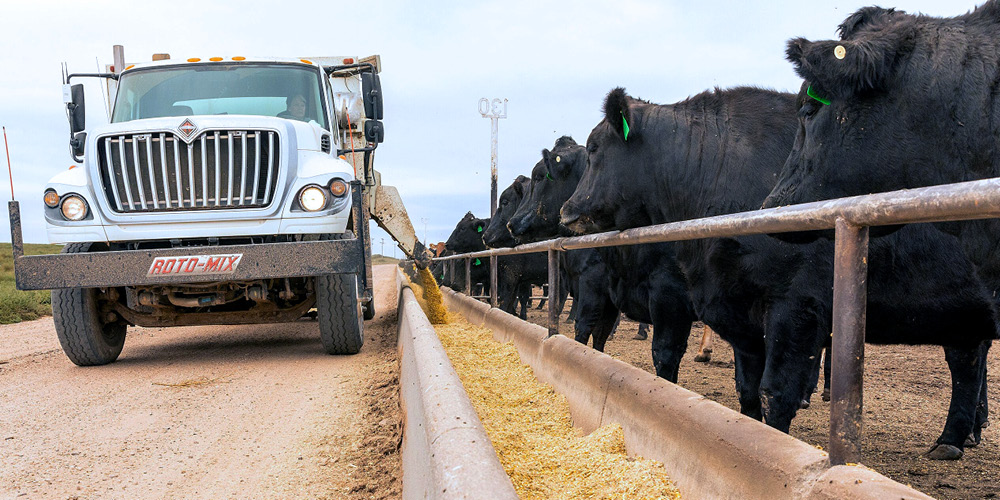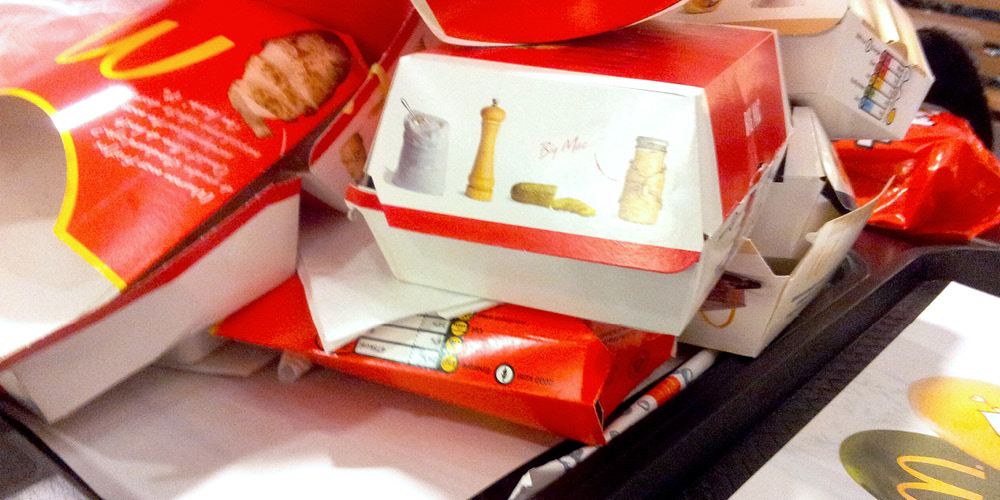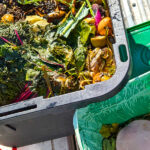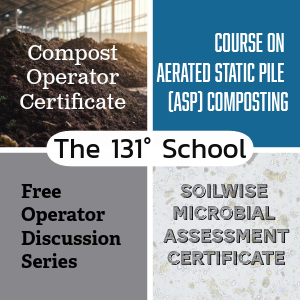Top: Bucolic Holmes County, Ohio farm (top) and McDonald’s food/packaging (bottom). Photos courtesy Valereee, CC0, via Wikimedia Commons, Dinkun Chen, CC BY-SA 4.0, via Wikimedia Commons, manipulated by BioCycle
 Sally Brown
Sally Brown
In Part I of this Connections’ series, I talked about how PFAS can get to soil — soil in Ohio to be exact. In principle we all care deeply about our soil. We recognize that it is alive, is critical for carbon storage, and that it grows our food. However deeply we care about soil and soil health, we care even more deeply about our own health. Human health, i.e., exposure to PFAS via biosolids, was also the focus of the U.S. Environmental Protection Agency’s proposed risk assessment. In its exercise, EPA modeled a farm family that either grew animal feed or vegetable crops. The farm had a fish pond that the family drank water from. The family ate the food they raised (meat, chickens, eggs). The soils received 400 metric tons/hectare (ha) (178 tons/acre) of biosolids applied over time and the family lived on that farm for ten years.
A first question is does this farm and associated family actually exist? A goal of risk assessment is to model the worst case and that is often different from reality. The farm family that EPA describes seems pretty bucolic to me. Afternoons spent at the pond, catching dinner. In the morning, heading to the chicken coop to gather eggs for the family omelets. Slaughtering poor Bessie, the family heifer, to put beef on the table for the months to come.
Risk Assessment Foibles
That bucolic vision is likely just that, a vision. I looked online for a family farm for sale, specifying one with an existing home and included fishing as an additional filter. I came up with seven results. None of these fit the EPA criteria for quantity of land and size of the pond. There are quite likely others out there that are currently not for sale, some of which might even fit the EPA modeling criteria. But I can say with certainty that they are a minority.
What do farms actually look like in Ohio? According to the USDA 2017 Census of Agriculture, Ohio had 77,805 farms. The primary revenue stream for those farms is crops, with corn (>$2 billion) and soybeans (>$2.3 billion) being the big earners. Animals are also a major commodity with >$1 billion from hogs and about the same for milk, and over 28 million layer hens (at least before bird flu). Much of the corn and soy grown in the state are used for animal feed.
Part of risk assessment is modeling potential pathways to human exposure. The draft EPA risk assessment focused on exposure through the land application of biosolids and consumption of products from those lands, narrowing its focus to scenarios involving farmers and individuals living near or relying on land where biosolids had been applied. The assessment primarily focused on ingestion of PFAS. What the EPA risk assessment did not consider is human exposure to PFAS from everyday consumer products that contain these forever chemicals, including — as illustrated below — in fast food packaging.
Land Applied Biosolids Pathway
As calculated in Part I, the amount of biosolids in Ohio that is actually land applied is enough to fertilize less than 20 farms. If you consider exposure via uptake to plants and then the plants to animals, the PFAS that would be applied with the biosolids would have to travel a circuitous route to impact people — even any farm families that did grow feed on biosolids-amended soils for their own animals that they then ate:
Biosolids to soil → Soil to plant grain → Grain to feed → Feed to animal
- Animal to the grill
- Animal to egg
- Animal to milk

Corn by-products processed into a grain feed for cattle. Photo courtesy KSRE Photo, CC BY 2.0, via Wikimedia Commons, manipulated by BioCycle
In addition, several studies have demonstrated that at the normal (nonindustrial) ranges of PFAS in biosolids, uptake of these chemicals into the grain is small enough to be below detection limits. For example, Blaine et al (2013) looked at uptake into corn in farm fields that had been amended with urban biosolids (read domestic and industrial flow) at 50 metric tons/ha. They didn’t find any in the corn grain with concentrations in the stover just over detection limits. A recent study looked for PFAS in oats grown in soils at three sites, including one that had gotten biosolids since 1978 (Black et al., 2025). Whole plants (not roots) were analyzed. Not a trace of PFAS was found.
Dirt Consumption Pathway
Even if you eat field corn and soybeans that don’t take up PFAS, they likely take up some dirt. Direct ingestion of soil was included in the EPA model, which estimated that kids over 12 and adults would eat 10 mg of soil each day. Eating soil is not so unusual as it sounds. Think of not perfectly washed fruits and vegetables. A little bit of dust on your hands. It is much easier to consider 10 mg when you remember what a small number that actually is: there are 454 grams in a pound and a milligram is 1/1,000 of a gram.
Let’s say that you added biosolids to soil that had 100 ppb of total PFAS at the rate EPA modeled of 178 tons/acre. The top six inches of soil typically weighs about 1,000 tons. That means, assuming that you are starting with a PFAS-free silt loam, that you are diluting the 100 ppb by about 5x when you mix it in with the soil. That 100 ppb in the biosolids translates to 20 ppb in the soil.
Biosolids to soil → Soil to humans
- Eat a kilogram of that soil and you will have ingested 0.02 mg of PFAS
- Eat 10 mg of that soil and you will have ingested 0.0000002 mg of PFAS
In Ohio the ground is frozen for part of the year and you are not likely eating much dirt when it is covered with snow. But for the sake of being conservative, eating 10 mg of dirt every day of the year means that you will eat 0.000073 mg of PFAS each year. This quantity has likely not instilled sufficient fear in your hearts to make you go wash your hands or your salad greens.
Fast Food Packaging Pathway
That does not mean that aside from the 20 farm families in Ohio, the rest of the farmers and everybody else in Ohio are not exposed to PFAS via their diets. Quite the opposite in fact. If farmers and others in Ohio are like their friends and neighbors, fast food is a much more regular feature in their diet than farm raised eggs. A quick search revealed that most people in the U.S. eat fast food one the three times each week. Thirty four percent of kids eat fast food every day. It is the rare individual that doesn’t frequent the double arches, with 87% of the population going to McDonald’s every year. The average person stops in 54 times each year. And you will likely not be shocked by this, but fast food typically does not come on fine china. It comes in some kind of packaging. And that packaging is very often laden with PFAS. Based on an analysis by Consumer Reports, McDonald’s packaging is pretty typical for fast foods in that the fries, cookies, big Macs and Chicken McNuggets all come with PFAS.

McDonald’s fast food packaging. Photo courtesy www.snack-nieuws.nl, CC BY 2.0, via Wikimedia Commons, manipulated by BioCycle
Now no one intentionally eats the packaging. But like soil, eating a little bit of the packaging likely happens when you are scarfing down those McNuggets. With that in mind, we can use the same ingestion rate for food packaging to estimate direct ingestion of food packaging. According to the Consumer Reports testing, PFAS in food packaging ranges from 7 million to 876 million parts per trillion. Too many zeros are making me dizzy here so let’s change units. That is 7 ppm to 876 ppm.
We can figure out how much PFAS the average person is likely to eat with their take out. For the low end, the wrapper that has 7 ppm PFAS, in addition to the excess sodium and trans fats (you can tell I am a snob about food), the takeout gives you 0.0007 mg of PFAS. On the high end, likely no additional sodium but much more PFAS — 0.09 mg. If you get the fries with the McNuggets, that likely means a double helping of PFAS. Assuming you get fast food like most people it is easy to calculate the potential quantities of PFAS that you eat.
Fast food packaging → Packaging to humans
- On the low end with the 7 mg of PFAS in the packaging and eating fast food 1x per week that comes to 0.036 mg of PFAS a year with your food.
- On the high end with 876 mg of PFAS and eating fast food 3x per week that comes to 13.7 mg of PFAS per year. If they floss their teeth after dinner, you can potentially double that exposure.
The Bottom Line
Compared with those farm families eating home grown food with biosolids-amended soil where PFAS ingestion totals 0.000073 mg annually, exposure via fast food packaging is a whole lot of forever. Not sure about you, but that bucolic farm life with that pond and those omelets looks even better in comparison. The point of this, which you have likely figured out, is that when you put risk assessment modeling into a real world context — and no arguing that Ohio is real world — the PFAS exposure potential associated with biosolids doesn’t even register as a blip.
To my knowledge, despite the headlines and headlong rush to ban biosolids as a result of forever chemicals, there has not been any effort on a federal level to consider the risks posed by the plethora of products that contain PFAS that we come into contact with daily. There also has not been any call to even label these products so that concerned consumers can do their best to avoid/reduce contact. If we really cared about human exposure to PFAS, it is only common sense that we start looking well before the flush.
Sally Brown, BioCycle Senior Advisor, is a Research Professor at the University of Washington in the College of the Environment.














